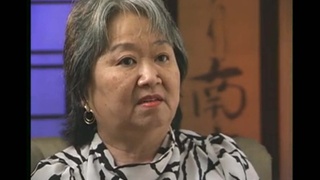Interviews
Move from Tule Lake to Minidoka
We had the same type of building, and it was just by coincidence that my mother and dad were sharing the apartment with the Uyeji family that we shared with in Pinedale. And I, my son and I were sharing the apartment with a family that we knew from Auburn, and this girl and her husband, and we had a blanket stretched across the middle of the room, separated their section from our section. And then next door, this girl's parents lived next door, on one side, and on the other side was a family that I didn't know, but we got acquainted. But it was the same way; there was about four or five families separated, and we had the potbellied stove and bed, and that was about all the furniture we had.
I had a table that this man, Mr. Tade, had built for me from scrap lumber in Tule Lake. So I disassembled it and brought it to Idaho, and planning to put it together, but then happened to burn up one of the -- [laughs] -- couple of the legs of the table during the time that we had a coal strike.
Date: September 15-17, 2004
Location: Washington, US
Interviewer: Alice Ito
Contributed by: Denshō: The Japanese American Legacy Project.






